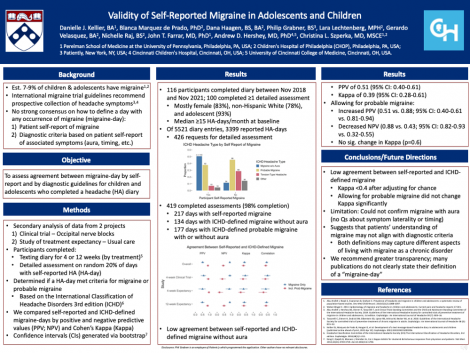Danielle Kellier
Validity of Self-Reported Migraine in Adolescents and Children
Abstract
Background: Migraine trial guidelines recommend prospective collection of headache features but there is no strong consensus on the definition of “migraine-day”. Such variations impact interpretation of one of the most common primary endpoints within migraine trials. In this study, we determined agreement between self-reported migraine and migraine according to diagnostic guidelines for children and adolescents who completed a headache diary.
Methods: This is a secondary analysis of text message-based headache diary data collected from participants in 2 larger projects for 4 or 12 weeks (depending on treatment). Participants completed a detailed headache assessment on 20% of self-reported headache-days from which we determined whether a headache-day met criteria for migraine or probable migraine, based on International Classification of Headache Disorders (ICHD). We calculated positive and negative predictive values (PPV; NPV) and Cohen’s Kappa (Kappa), comparing self-reported and ICHD-defined migraine.
Results: Of the 116 children and adolescents enrolled, 100 completed ≥1 detailed assessments during follow-up (419 entries). We found poor agreement between self-reported and ICHD-defined migraine, with a Kappa of 0.39 and PPV of 0.51, and NPV of 0.88. Allowing for ICHD-defined probable migraine increased PPV (0.51 [95% CI: 0.40-0.61] vs. 0.88 [0.81-0.94]) but Kappa did not change significantly (0.39 [0.28-0.50] vs. 0.32 [0.19-0.45]).
Conclusion: We found low agreement between self-reported and ICHD-defined migraine, even after including ICHD-defined probable migraine. This suggests that both measures are qualitatively different and may represent different aspects of migraine as a disease. Future studies would benefit from greater methodological transparency to avoid readers conflating both measures.
Keywords
Migraine; Pain Measurement; Self report; Mobile healthAbout Us
To understand health and disease today, we need new thinking and novel science —the kind we create when multiple disciplines work together from the ground up. That is why this department has put forward a bold vision in population-health science: a single academic home for biostatistics, epidemiology and informatics.
© 2023 Trustees of the University of Pennsylvania. All rights reserved.. | Disclaimer



